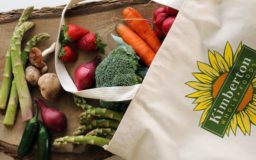Did you know that food is the #1 contributor to landfills by volume? It is estimated that up to 40% of US food is never eaten. This amount of food equates to a loss of about $218 billion dollars, and contributes to 2.6% of all US emissions. While 1 in 8 Americans are without steady access to food, just ⅓ of this food waste would feed them comfortably.*
Although the majority of this food waste is happening at an industrial, commercial level, it might make you think about your own food waste. Are you contributing to the problem? If the idea of food waste alone doesn’t rattle you enough, consider that the average family of four throws out approximately $1,484 worth of food and beverages each year. Continue reading for tips to make sure you get the most out of your purchases.

General Rules
Excess moisture is the enemy of fresh fruits and vegetables. Make sure your produce is dry before you store it. Wait to wash it until right before you use it.
At Kimberton Whole Foods, we offer compostable produce bags, which are great because they can be tossed in your home compost pile. (If you don’t compost at home, you can throw these in the garbage – they will biodegrade unlike the plastic alternative.) However, the compostable bags are not ideal for long-term produce storage, since they do break down quickly. We recommend removing any delicate produce, such as lettuces, from the bags when you get home and transferring them to a traditional plastic bag, with a dry tea towel to absorb moisture. (Save the compostable bags for collecting compostable food scraps!) We like reusing & repurposing plastic bread bags or zip-top bags for this purpose. Or, simply skip the extra step and bring your own bags when you shop for produce. A word on mushrooms: Loose mushrooms will not hold up in plastic or compostable bags. We suggest storing them in a paper lunch bag for best results.
Ethylene Gas
Some fruits and vegetables should be stored separately due to a natural gas that some fruits emit, called ethylene gas. It can speed the ripening process of some fruits and vegetables, which is undesirable if you’re trying to get the longest shelf life out of your produce. Keep high-ethylene gas-emitting fruits (apples, avocados, stone fruits, pears, bananas, and tomatoes) apart from other produce. You’ll also want to separate onions from potatoes, which can sprout more quickly when onions are near.
On the bright side, if you’re looking to ripen produce faster, you can use ethylene gas to your advantage: place an unripe avocado in a brown paper bag with an apple or banana for two to three days to speed ripening.
Storing Herbs
With the exception of basil, fresh herbs are best stored in the refrigerator with a damp paper towel to keep them fresh. Or, store like a bouquet of flowers by trimming off an inch or so of the stem and sticking them in a jar of water in the refrigerator with a plastic bag loosely covering the bunch. This also works for asparagus: “You can store asparagus in a glass of fresh water in the refrigerator – just trim the ends, add about an inch of water, and cover loosely with plastic.” -C.J. KWF Team Member
Produce team member, Emme, recommends The Jar Method. In this course, the creators offer advice to keep your produce fresher, longer – from how to clean it properly, to where to store certain items in your refrigerator. The advice applies mostly to cut and prepared produce.
Best Temperatures for Storage
Room Temperature
- Bananas
- Garlic & Onions
- Potatoes & Sweet Potatoes
- Basil (trim and store as described under “storing herbs” above, but do not refrigerate)
- Tomatoes
Squash: summer, winter, and zucchini
Room Temperature Until Ripe, Then Refrigerate
- Stone Fruit: apricots, nectarines, peaches, plums, avocados, mangoes
- Tropical Fruit: kiwifruit, papayas, pineapple
- Melons
- Pears
Refrigerate
- Apples
- Tender Spring Vegetables: asparagus, peas
- Tender Fruits: blueberries, strawberries, raspberries, cherries, grapes, pomegranate
- Citrus: lemons, limes, oranges, grapefruit
- Tender Herbs: parsley, cilantro
- Cruciferous Vegetables: broccoli, brussels sprouts, cabbage, cauliflower
- Root Vegetables: carrots, beets
- Corn (whole ears in the husk)
- Greens: dark leafy greens, lettuce
Making Stock with Food Scraps
Another great way to reduce food waste is to use as much of your produce as possible – including peels and stems! Kimberton Whole Foods customer, Elaine, suggests, “Some leftover veggies (not suitable for dinner, but still have life) can make great additions to stock. This includes celery tops, kale, broccoli stems and other items that might otherwise end up in the landfill.” We suggest trying these recipes for Carrot Top Pesto and Roasted Potato Peels.
Do you have a great storage tip? Share with us in the comments below!
*Information courtesy of Climate Collaborative









